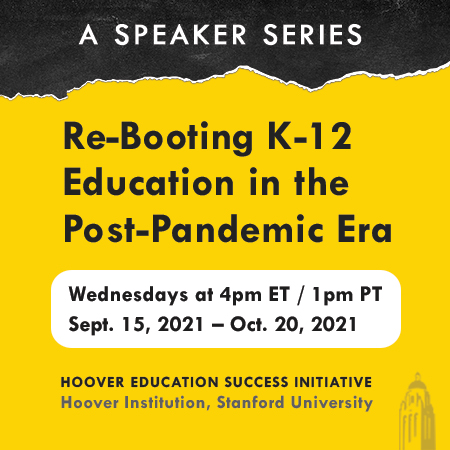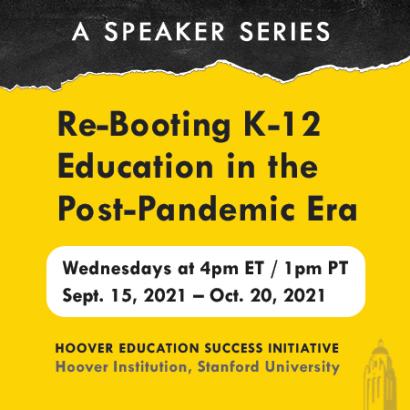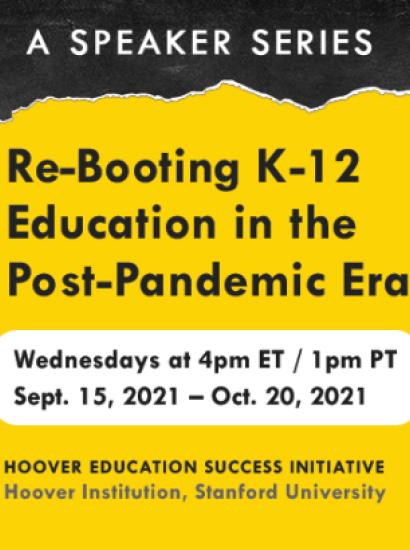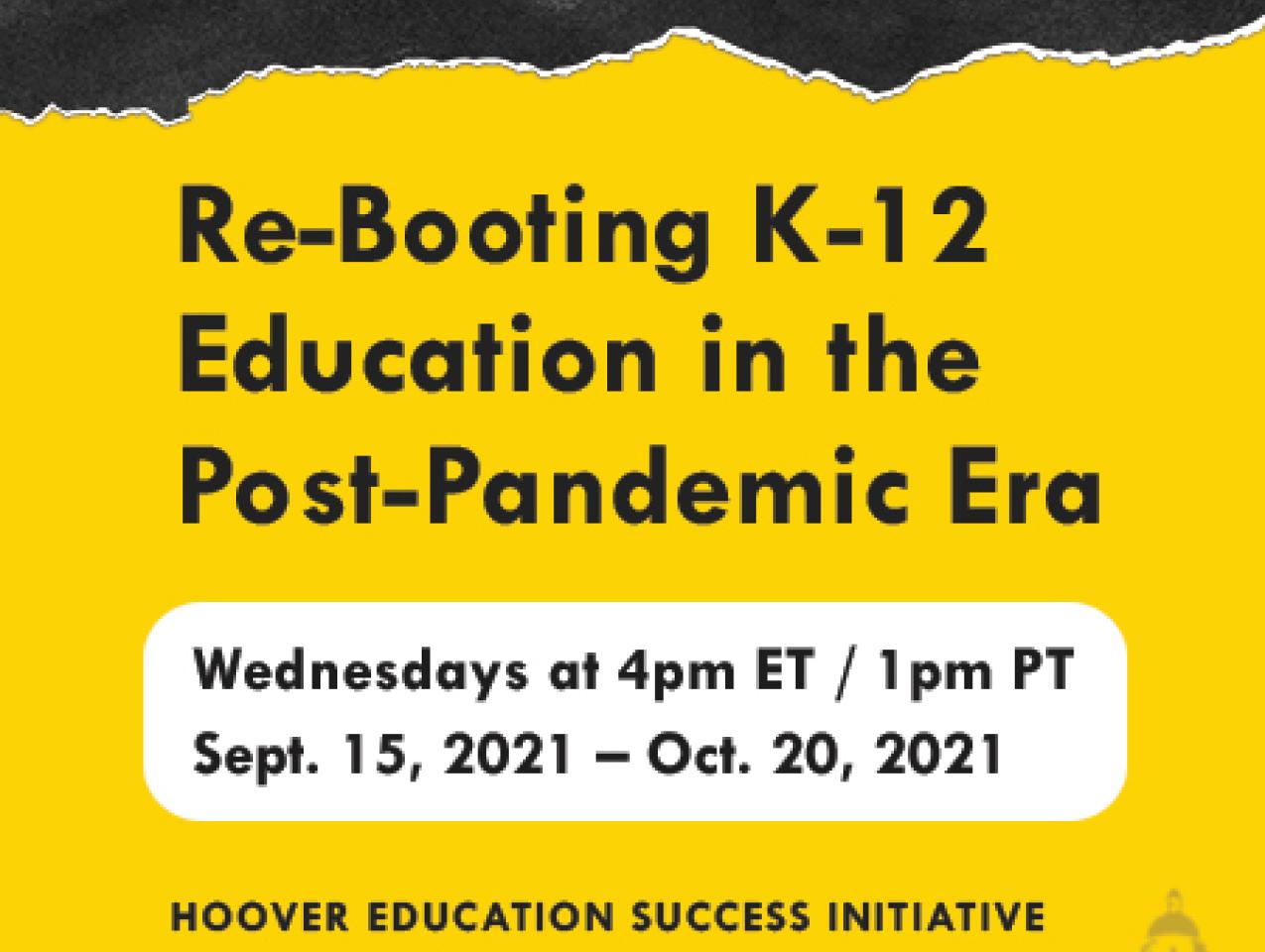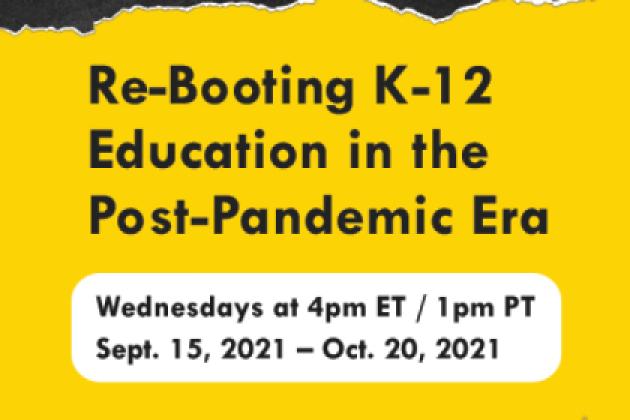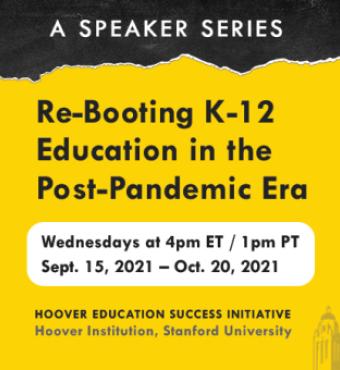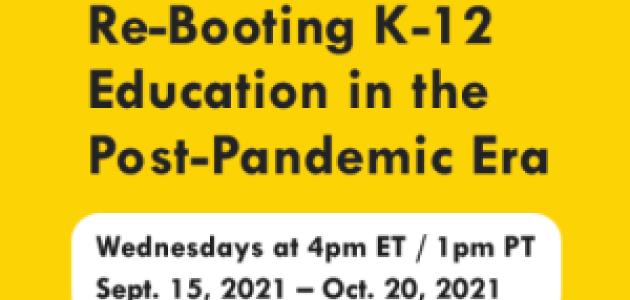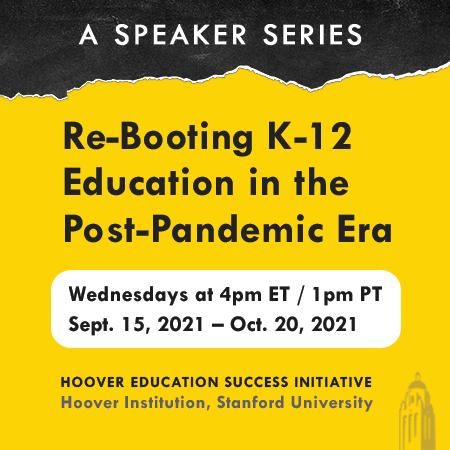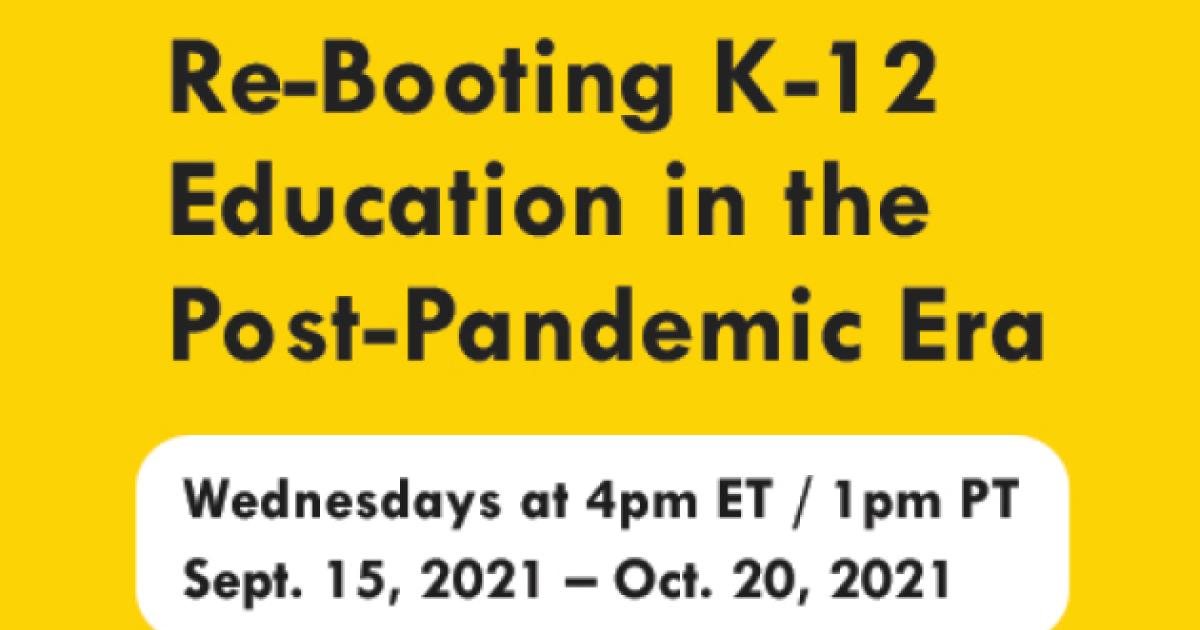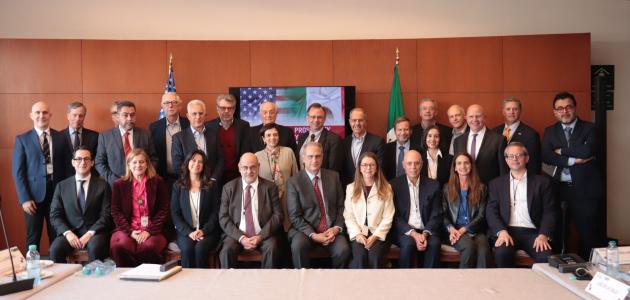Hoover Institution (Stanford, CA) -- The Hoover Education Success Initiative (HESI) presented a six-part webinar series this fall that explored how public education can improve moving forward given the ongoing disruption of in-person instruction caused by COVID-19-inspired restrictions, as well as foundations of the system that needed reform prior to the pandemic.
The series covered a variety of policy issues, including teacher compensation, the role of media in education reform, school choice, school accountability, student achievement, and which stakeholders need to be involved in reform efforts.
Each conversation featured Hoover scholars who are conducting cutting-edge research, as well as other leading education experts, many of them members of HESI’s Practitioner Council, who offered their perspectives about putting policy ideas into action.
Will Increasing Teacher Pay Harm Students?
The first session, on September 15, 2021, addressed the correlation between teacher compensation and student outcomes. The program featured Eric Hanushek, the Hoover Institution’s Paul and Jean Hanna Senior Fellow; Holly Boffy, District 7 representative of the Louisiana Board of Elementary and Secondary Education; and Kent McGuire, program director of the William and Flora Hewlett Foundation. Christopher Ruszkowski, distinguished policy fellow at the Hoover Institution, moderated the discussion.
Hanushek emphasized how school closures have exacerbated disparities in outcomes between schools that have quality teaching forces versus those that do not. In his remarks, he referenced an essay he wrote for HESI in January 2019, “The Unavoidable: Tomorrow’s Teacher Compensation.” In the essay and webinar, Hanushek argued that a key factor for the improvement of the K–12 education system is for schools to increase the supply of effective teachers through generous compensation packages. Such an effort, he maintained, should include lowering the barrier of entry for people aspiring to join the teaching profession while tying their employment and pay to student performance.
Boffy agreed with Hanushek’s recommendation about teacher pay and also emphasized that attracting people to the profession would greatly depend on restructuring a greater proportion of compensation in favor of front-end salary increases rather than retirement benefits.
McGuire concurred with Hanushek that holding teachers to high standards and increasing competitiveness within the profession will improve educational outcomes for students. However, McGuire added that more needs to be done to prevent the best teachers from leaving for other industries.
All panelists maintained that disruptions caused by the COVID-19 pandemic have created the opportunity for school systems to reallocate their teaching force so that individual professionals can specialize across instructional modes—in person, virtual, or hybrid—according to their strengths.
Can We Replace Seat Time with Mastery?
On September 22, education scholars and practitioners discussed whether current circumstances should prompt changes in how best to measure student mastery over subject matter and prepare young people for college and careers. The panel featured Macke Raymond, distinguished research fellow and program director in education at the Hoover Institution; Chad Gestson, superintendent of the Phoenix Union High School District; and Don Shalvey, CEO of San Joaquin A+. The program was moderated by Stephen Bowen, deputy director for state leadership at the Council of Chief State School Officers.
Raymond began the discussion by describing the Carnegie Unit, a system that measures the amount of time a student has spent studying a particular subject in school and that awards corresponding course credit. As Raymond explained, the system, founded in 1906 by industrialist and philanthropist Andrew Carnegie, was originally implemented at the college level but then was adopted and standardized in high schools across the United States to demonstrate whether students were prepared for postsecondary education. She argued that the Carnegie Unit is not a valuable metric, because it measures inputs (seat time) as opposed to outputs (mastery over a subject). She recommended that high schools coordinate with postsecondary institutions to assess achievement on the latter basis.
Gestson affirmed Raymond’s argument about the need to measure students’ college readiness by mastery of subject matter. To this end, he argued that mastery isn’t necessarily achieved by spending significant amounts of time in the classroom with a constrained focus on a particular subject. Instead, classroom teaching can be supplemented by extracurricular activities such as career-oriented internships. As well, schools can provide diverse course offerings that combine complementary subject matter with real-world applications, such as art and science, and music and mathematics.
Don Shalvey asserted that high schools need to collaborate more closely with higher-education institutions, especially community colleges, to set students on a clear pathway toward meaningful degrees and career certifications. He also underscored that secondary schools should align student outcomes with the needs of their communities. As an example, he explained that a focus of his organization is emphasizing instruction and career preparedness in agriculture, because of the centrality of that industry to the economic life of California’s San Joaquin Valley.
All participants agreed that the current moment presents a unique opportunity to make substantial reforms in education, given the strong appetite for change among parents whose children have experienced significant amounts of learning loss during the course of the pandemic.
Fourth Estate or Fifth Wheel? The Role of the Media in Education Reform.
On September 29, the series’s third session covered the media’s role in education reform and featured professionals and policy makers including Hanna Skandera, CEO of the Daniels Fund; Mike Cohen, senior fellow at CenterPoint Education Solutions; and Manny Diaz Jr., Florida state senator representing District 36 in Miami-Dade County. The program was moderated by Jenn Vranek, founding and managing partner at Education First.
Vranek initiated the conversation by asking whether journalism professionals today generally support or undermine education reform. Cohen responded by asserting that the news media has had a positive track record of producing substantive stories related to how well K–12 schools are preparing students for postsecondary education and meaningful career paths. However, Cohen explained that he is less sanguine about coverage on national common core standards, which in his opinion suffers from highly politicized reporting and opinion making in both traditional and social media channels.
Diaz and Skandera said that they would like to see journalists write stories about how parents became more engaged in their children’s education throughout the course of the pandemic.
For Skandera, such reporting would cover how these parents are now navigating the new education landscape, which includes entrepreneurial ideas that have become more prominent in the wake of disruptions to in-person instruction. Diaz argued that more media attention should be given to “courageous out-of-the-box thinking” formulated by policy makers and educators about the future of schooling. He said, however, that journalists might be hesitant to highlight such stories, because traditional media institutions are often closely aligned with teachers’ unions, who are obstinate to change.
Cohen emphasized that although he agreed with the other panelists on the benefits of more publicity about positive gains in education reform, he affirmed that serious journalists who at the current moment are devoting a majority of their coverage to stories involving school safety during the pandemic are providing legitimate, and very necessary, information to the public.
Can We Choose Our Way to Better Schools?
The fourth session, on October 6, 2021, addressed the future of the school-choice movement. The program featured Starlee Coleman, CEO of the Texas Charter Schools Association; Paul E. Peterson, Hoover Institution senior fellow; and Robert Enlow, president and CEO of EdChoice. The program was moderated by Wayne Lewis, president of Houghton College and former commissioner of education for the Commonwealth of Kentucky.
Peterson began the session by commenting on the current state of the school-choice movement. He noted that when charter schools started to become more popular two decades ago, they performed evenly with their district counterparts. Today, there is a noticeable difference; charters are now vastly outperforming traditional public schools. Despite this deficit, traditional schools have also improved, because charters and other choice movements have encouraged greater competition in the education landscape. Peterson argued that these trends are especially apparent in some African American communities.
Enlow agreed that school choice has improved educational outcomes for students but held that policy makers need to do more to expand options for disadvantaged and minority children. He noted that children who live in poorer communities don’t have the personal finances nor per-pupil public funding that would give them the same chance to succeed as students living in more affluent neighborhoods. Furthermore, existing charter schools in those low-income communities are often filled to capacity.
The panelists also commented on the importance of increasing the supply of minority educators. Coleman said that the data demonstrates that African American students, for example, have achieved better academic outcomes when they have had Black teachers. She also indicated that African American and other minority education leaders face the challenge of a complex state regulatory structure when trying to start their own charters or other choice programs. Many cannot afford the expense of hiring a lobbyist to help them navigate the education policy environment.
Peterson asserted that the subpar performance of traditional public schools during the pandemic has given new momentum to the school-choice movement. The number of homeschoolers has doubled; many parents have also become more engaged in their children’s education and are exploring alternatives such as hiring private tutors or forming learning pods with other families.
Enlow said that, by and large, learning environments are unlikely to return to the way they were during the pre-COVID era. He argued that the pandemic has underscored that the one-size-fits-all nature of the public education system leads to disparities in learning outcomes. Instead, he advocated for “backpack funding,” whereby students would be allotted their individual portion of public-school funding and use it to enroll in any school of their choice.
Who Needs to Be “In the Room Where It Happens” to Improve US K–12 Schools?
The October 13, 2021, session focused on important stakeholders in the education policy-making process, and how they should coordinate their actions to realize positive outcomes for student achievement. The panel featured Margie Vandeven, commissioner of elementary and secondary education for the Missouri State Board of Education; Derrell Bradford, president of 50CAN; and Christina Laster, director of policy and legislation with the National Parents Union. The program was moderated by Macke Raymond, distinguished research fellow at the Hoover Institution.
This session between leading experts and advocates focused on important stakeholders in the education policy-making process, and how they should coordinate their actions to realize positive outcomes for student achievement.
Vandeven argued that the most important stakeholders are organizations that best represent student interests. She emphasized that coalitions of such groups are more effective when they are broad, diverse, and disciplined in the message they intend to convey.
Laster said that during the course of school closures resulting from the COVID-19 pandemic, parents largely weren’t given deferential treatment by school boards and other elected officials. This was despite the failure of many schools to deliver a quality education and prevent the significant learning losses that occurred during that eighteen-month period.
Vandeven emphasized that her constituents have largely been split on the future of instruction. Ultimately, she believes that all stakeholders are pursuing the same goals of school safety and expanding opportunity for students to receive a quality education. The disagreement lies in the policies put forth to achieve their shared ends of putting students first.
To this point, Laster added that policy conversations should be outcome oriented and grounded in unbiased data. She also said that the formulation of policy should be directed toward the transition from a one-size-fits-all learning structure to one that accommodates personalized modes of instruction.
Bradford asserted that the solution to improving public education systems should address not just improving average student achievement but also providing support to those schools in inner cities and rural areas that are struggling to keep pace.
All participants agreed that improving public schools in the post-COVID era will require a shared and actionable vision from policy makers, educators, and parents, as well as other leaders in local communities who have a stake in enhanced educational outcomes.
Has Accountability Outlived Its Shelf Life?
On October 20, 2021, scholars and policy makers convened for the final session, which covered how accountability measures can be reformed to address the performance of schools impacted by the pandemic. The session featured Michael Kirst, emeritus professor of education and business administration at Stanford University and former president of California’s state board of education; Chester E. Finn, Jr., Hoover Institution senior fellow; and James Peyser, secretary of education for the Commonwealth of Massachusetts. The program was moderated by Melanie Barton, senior education advisor to the governor of South Carolina.
Peyser started the conversation by arguing that accountability programs and standard-based reform alone cannot improve poorly performing schools. He said that the Every Student Succeeds Act (ESSA), the national law that governs education policy, should not be overhauled and that schools should resume the national assessments that have been on pause since March 2020, when schools across the country shut down due to public health restrictions in the wake of the COVID-19 pandemic. However, he maintained that within the ESSA framework, the burden should be placed on state governments to improve accountability programs. He stressed the need to close glaring national achievement gaps, including providing support for a large proportion of students who have failed to reach a sufficient reading level by the third grade.
Referencing his recent HESI essay, “Results-Based Accountability for Schools: Education’s Heaviest Lift,” Finn also emphasized that the country should resume national assessments. He explained that currently, testing data is vitally important not only because it gauges proficiency but also because it indicates how schools need to prepare students for their next level of education. He said that accountability programs should focus on aspects of students’ development that testing doesn’t measure, including character and social and emotional well-being. Furthermore, he asserted that policy makers should seek alternative accountability measures instead of just resorting to interventions and closures of badly performing schools. Recognition should be given to schools that are enabling their students to excel. Additionally, he maintained that a student should be able to obtain an exit visa, that is, the option of leaving a poorly performing school in favor of attending one of their choice.
In his remarks, Kirst argued that student assessments should be closely aligned to content being taught daily in the classroom. This would allow educators to provide formative testing, without having to reteach subject matter for a year-end summative test. He also stressed that subject matter standards should be tied to preparation for courses at the postsecondary level.
Click here to learn more about HESI.







